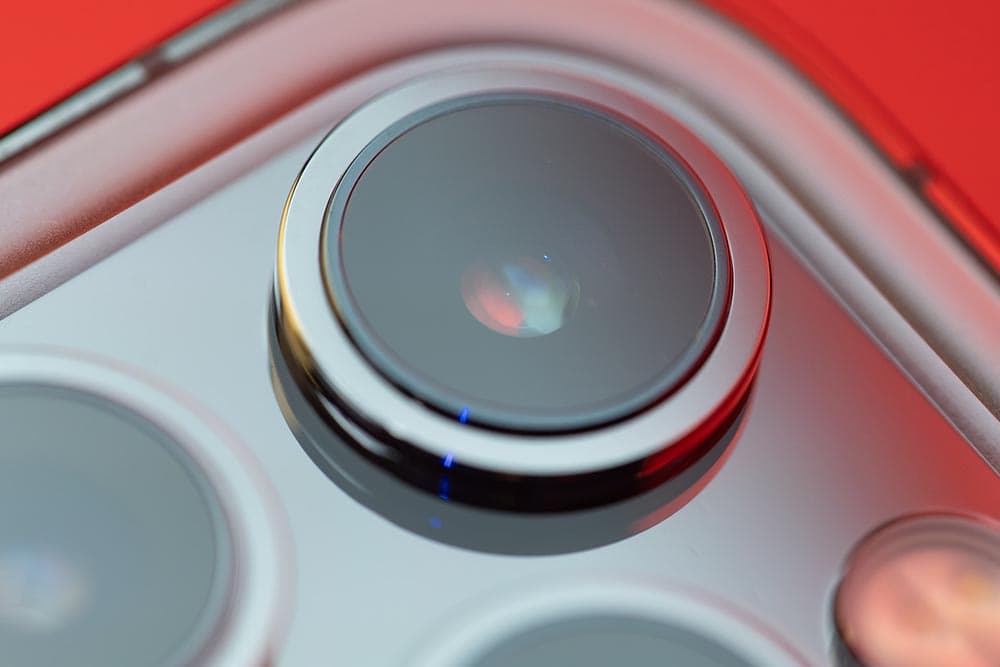What is an iPhone’s Focal Length?
Last Updated on

The newest pack of iPhones hit the market with an array of new features, including improved cameras with super-wide and wide-angle lenses and an f/1.6 aperture for a focal length of 26 mm. The iPhone Pro and Pro Max have a three-lens camera system with a 77 mm telephoto lens, a 26 mm wide lens, and a 13 mm ultra-wide lens.
Learn more about the new features and capabilities of the iPhone 13 and why they matter.

What is Focal Length and Why Does It Matter?
Focal length is typically represented in millimeters and describes a photographic lens. It’s not a measurement of the lens itself but a calculation of the distance from the point where the light rays converge to form an image to the digital sensor at the focal plane of the camera.
The focal length shows the angle of view, or how much of the subject can be captured, and the magnification, or how big the individual elements can be. The longer the focal length (70 mm), the narrower the view and the higher the magnification. Conversely, the shorter the focal length (28 mm), the wider the angle of view and the lower the magnification.

Prime lenses have a fixed focal length, and zoom lenses have variable focal lengths. Focal length impacts the composition and quality of a photograph in many ways:
- Field of view: Focal length determines how much of the image can be captured. A shorter focal length lens may be called a wide-angle lens since it offers a wider field of view in one image. A longer focal length is a telephoto lens, which has a narrower field of view.
- Depth of field: Lenses with long focal lengths have a shallow depth of field, which means that they can focus on small objects with clarity at specific distances. Shorter focal lengths have a larger depth of field, so they can capture a range of elements in focus.
- Perspective: Focal length can influence the perspective and scale of an image. Shorter focal lengths expand the perspective, creating an illusion of more space between the photographer and the subject. Longer focal lengths have a look of “stacked” elements and a compressed perspective.
- Image shake: Focal length can impact image shake or the blurriness and reduction in quality that happens from the natural vibrations of pressing the shutter. A lens with a long focal length and tight perspective is more sensitive to these vibrations, leading to more blurriness.
Crop sensor cameras, such as those in smartphones, have smaller sensors and smaller lenses. Their focal length can seem far off from that of a full-frame camera, but they’re equivalent. For example, a full-frame camera may have a prime lens with a focal length of 50 mm, which is roughly the same as the human eye’s field of view. The equivalent on a crop sensor camera is 35 mm.
Telephoto lenses are around 70 mm focal length, which is roughly 45 mm on a crop sensor camera. For a wide-angle lens, the focal length is around 28 mm or shorter, which is about 18 mm on a crop sensor camera.
The iPhone has a focal length of 26 mm, while the iPhone Pro and Pro Max have a three-lens camera system with a 77 mm telephoto lens, a 26 mm wide lens, and a 13 mm ultra-wide lens. These are the full-camera equivalents, not the true focal length of the crop sensor camera.

2024 iPhone Releases
2022 brought two new editions of the iPhone: the iPhone 13 and the third edition of the iPhone SE. The 13 comes in several models: the iPhone 13 Mini, iPhone 13, iPhone 13 Pro, and iPhone 13 Pro Max.
Along with the lenses, Apple added new sensors in the 13 model, though they’re 12 megapixels in resolution like the iPhone 12. It also comes with additional photography features, including sensor-shift optical image stabilization, Picture Styles for stills, Cinematic Mode for video, and the new A15 Bionic chip for improved speed.
Several new specifications expand on the previous generation as well, including Night Mode, Portrait Mode, and 4K video recording capabilities.

Conclusion
We’ve all seen the spectacular “Shot on iPhone” ads that showcase what the average person can accomplish with the smartphone’s camera and video features, including the iPhone 13’s three-camera system. Thanks to this technology, everyone from amateurs to professional photographers can use their iPhones to create polished, portfolio-quality images and videos.
Featured Image Credit: TheRegisti, Unsplash
About the Author Robert Sparks
Robert’s obsession with all things optical started early in life, when his optician father would bring home prototypes for Robert to play with. Nowadays, Robert is dedicated to helping others find the right optics for their needs. His hobbies include astronomy, astrophysics, and model building. Originally from Newark, NJ, he resides in Santa Fe, New Mexico, where the nighttime skies are filled with glittering stars.
Related Articles:
How to Clean a Refractor Telescope: Step-by-Step Guide
How to Clean a Telescope Eyepiece: Step-by-Step Guide
How to Clean a Rifle Scope: 8 Expert Tips
Monocular vs Telescope: Differences Explained (With Pictures)
What Is a Monocular Used For? 8 Common Functions
How to Clean a Telescope Mirror: 8 Expert Tips
Brightfield vs Phase Contrast Microscopy: The Differences Explained
SkyCamHD Drone Review: Pros, Cons, FAQ, & Verdict
